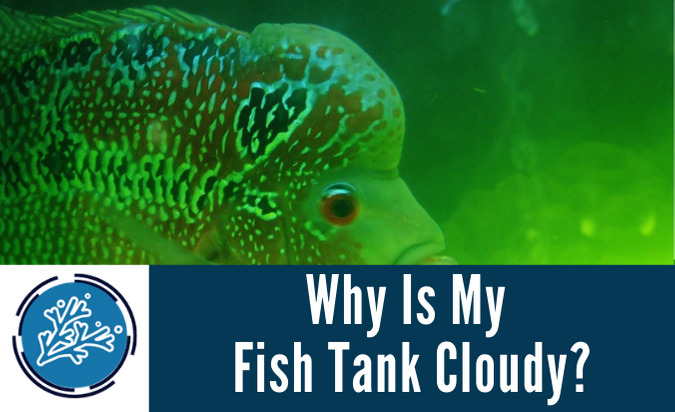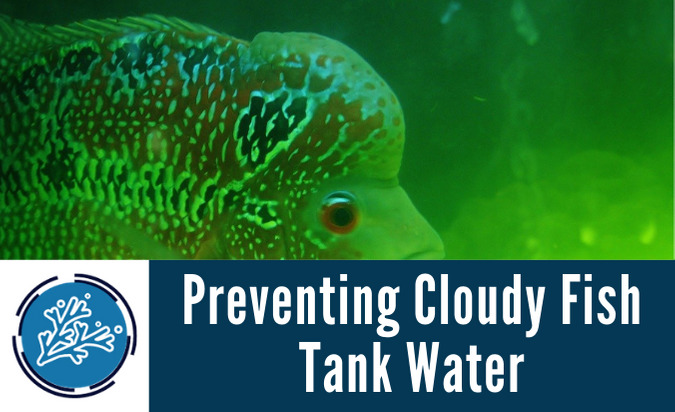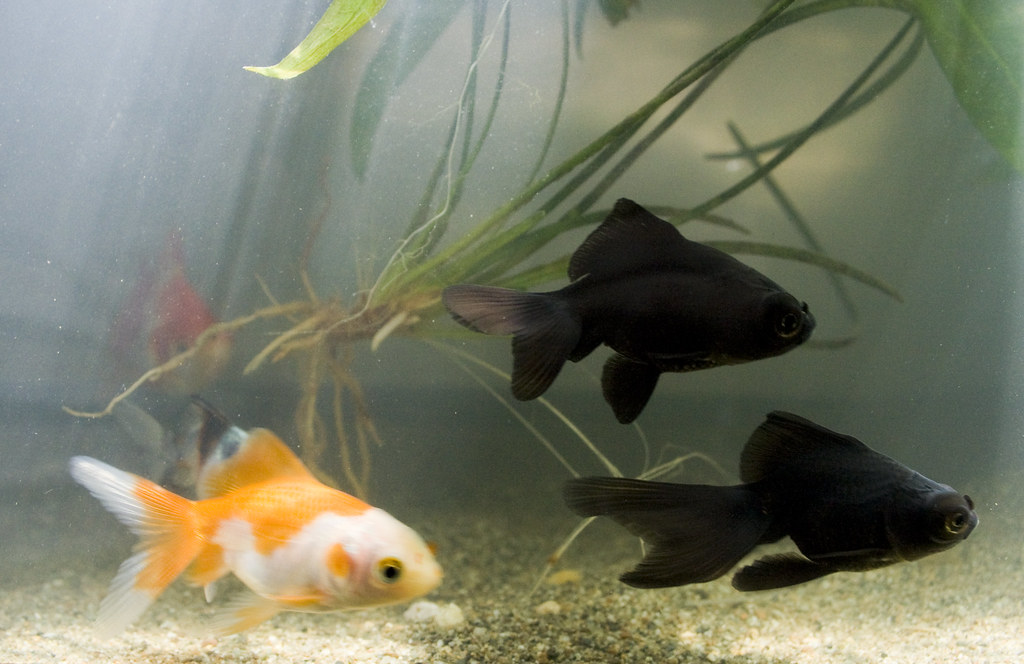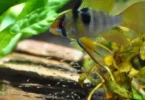Last Updated on February 10, 2023 by Matt
All aquarists will suffer with cloudy aquarium water at some point. Either initially during the set up phase, before the filtration system has settled down and you’ve established an appropriate feeding regime for your fish, or at some point in the future.
It’s basically inevitable, and every aquarium owner will experience this at some point.
This guide to cloudy aquarium water aims to explain why fish tanks become cloudy, what different colored water could mean, and what you can do to combat this.
IN THIS ARTICLE
Why Is My Fish Tank Cloudy?

For new aquariums, those that have been running for less than six months, cloudy tank water is quite a common phenomenon.
The clue to the underlying reason behind the murky water often lies with the color. Cloudy aquarium water can be grey, white, green, or brown. All have different causes and solutions.
There are numerous answers to why is my fish tank water cloudy? Opaque or murky water can be caused by free floating algae, bacterial issues or even something as simple and benign as a recent gravel change.
Grey or White/Opaque Cloudy Aquarium Water
There are a couple of reasons why your aquarium might have grey or white/opaque water. We will run over both of them in the following section, and also outline possible solutions.
Reason 1: Inadequately washed gravel or substrate
If your tank water is murky and opaque shortly after filling the tank or after performing a substrate change, then it’s most likely due to inadequately washed gravel/substrate.
Unfortunately, this could involve emptying your aquarium of water and rinse the gravel properly until water runs clear through the gravel. This is laborious, so best avoided by ensuring that all gravel is thoroughly rinsed before introducing to the aquarium.
It’s possible that a 50% water change will solve the problem, which will avoid the need to remove all your fish. Water changes can be made easier using a product like the Python water changer.
Either way, add the water very slowly to your aquarium once you’ve returned the properly rinsed substrate. If you have to use a bucket, add the water extremely slowly or it will stir up the substrate excessively.
The addition of an exceptionally fine mechanical filter medium may also help by catching these fine substrate particles, and could prevent the need for any water change.
A polishing pad will remove very fine particles in your water, and hopefully solve the problem. We have selected some Polishing Pad options below to aid your choice
- SPARKLING CLEAR WATER: Our 100 micron filter pad has a dense fiber network to effectively trap fine to extra fine particles floating in your aquarium...
- TRAPS FINE PARTICLES - Our 100 Micron Polishing Filter Pads’ dense fiber network traps large to very fine particles floating in your freshwater or...
- CUT TO FIT - This 24 inch by 36 inch by 1/8 inch thick filter pad can easily be cut to size and will save you even more money over purchasing...
This product is suitable for freshwater and saltwater aquaria alike.
The 100 Micron polishing filter pad’s dense network of fibers traps the ultra fine particles floating in your aquarium, resulting in extremely clear water.
Extremely durable, the polishing pad can be cleaned and reused many times over.
It is easy to cut this pad to fit your own filtration system, and it can be used either alone or in combination with other filter pads in a layered system.
- Extra thick micro-fine polyester pads capture micro particles as the water passes through the pad
- Use when cloudy water occurs or after tank maintenance for crystal clear aquarium water
- For use with freshwater or marine environments
- Contains six water polishing pads
This product by Fluval is a 6 pack of extra thick micro-fine polyester pads, that will capture micro particles as the water passes through the pad.
Particularly recommended for cloudy water situations upon tank set up or after tank maintenance. The result should be crystal clear aquarium water.
- Captures small particles
- Suitable for freshwater or marine environments
- Best if used in conjunction with Fluval Water Polishing Pads
- 3-pack
This fine filter polishing pad by Fluval is also suitable both for freshwater and saltwater/marine environments.
It will capture the fine particles within your tank, rendering the water beautifully clear.
Reason 2: Bacterial Bloom
To fully understand the science behind bacterial bloom, or bacterial blossom as it is commonly known, you need to understand the concept of the Nitrogen Cycle.
In brief, the primary cause of bacterial bloom in an aquarium is an excess of organic matter resulting in the reproduction of heterotrophs to break down the organic waste.
It’s important to distinguish between heterotrophic and autotrophic bacteria. Autotrophic bacteria are the type used in biological filters and are useful within the aquarium. They can synthesize their own food.
Heterotrophic bacteria, on the other hand, are unable to synthesize their own food and instead break down organic waste within the tank, and the process creates the bacterial bloom.
The excess organic matter can result from over feeding your fish and the resultant food debris remaining on the tank substrate – this is one of the primary reasons. Dead fish and/or aquatic plant detritus will also add to the organic matter load if not promptly removed.
In simple terms, the heterotrophs reproduce quickly in the presence of this organic waste which causes bacterial bloom
Green Cloudy Aquarium Water
Although not particularly harmful to fish, green water is caused by a buildup of free floating algae within the water. This algae will also adhere to the aquarium glass and any decorative items within the tank.
Causes Of Algae Build Up
There are many contributing factors to algal blooms in aquariums, which then cause green cloudy fish tank water.
A primary cause is excess light and poor light control. Adequate LED lighting is essential in fish tanks, but you need to ensure aquarium lights are not too bright nor kept on for too long. If your LED lights are too powerful for the size of your tank then you are at risk of algae using this intense light to fuel growth.
Also ensure your aquarium is not in direct sunlight; this will encourage algae growth. It’s also not a good policy generally due to temperature control. The aquarium heater and thermometer will control the temperature of the tank, but direct sunlight will heat up the water and can cause fluctuations in temperature.
A high nutrient load will also contribute greatly to algal blooms and growth. Nitrate and phosphate are very important plant fertilizers and are important sources of nitrogen and phosphorus respectively. But it concentrations get too high algal growth can get out of control.
How to remove a bacterial bloom in your Aquarium
Start by monitoring carefully the amount of food your fish eat by observing them at regular intervals after feeding them. Add a small amount at a time, ensuring it has all been eaten before adding the next small quantity. It won’t take long to become familiar with the fish eating habits and the correct quantities to feed.
Then continue by feeding to a schedule. It creates a healthy feeding rhythm that the fish adapt to, and prevents uneaten food detritus building up within the tank substrate.
If you do notice any eaten food, remove it promptly.
Include some scavenging fish in your tank population. Mostly bottom feeders like catfish and loach species like clown loach and kuhli loach. These scavengers will use their sensitive barbels to locate waste food on the aquarium floor. They do a great job!
Water Quality – Nitrate and Phosphate Levels
Adequate aquarium maintenance is essential to healthy water. Regularly cleaning your aquarium filter reduces nitrate levels. Excess nitrates in the water provide fertilizer for both aquatic plants and algae. You have to get the balance right to ensure that algae and plants do not grow and proliferate excessively. Very high nitrate levels will also cause nitrate poisoning in your fish.
All living organisms contain phosphorus. If dead plant or fish detritus or rotting food particles are allowed to accumulate on the tank substrate, this will result in phosphate levels in the tank becoming excessively high.
Ensure that you vacuum your substrate or gravel and thoroughly rinse your filter and media at every water change to ensure water health.
Clean the tank thoroughly by scraping the inside of the aquarium glass. Remove rocks and tank decorations and be sure to scrub them well. Leave to allow the water to settle and then vacuum the substrate again.
Brown Or Yellow Fish Tank Water
A brown tinge to your aquarium water is probably due to discoloration by tannins. Tannins are organic compounds within the water but they are not necessarily harmful pollutants, in the same way as nitrates.
However, tannins may lower the pH in your tank – not dramatically, but it can lower it.
Tannin is a natural astringent that can leak into the water from the addition of driftwood as a decoration. Indian almond leaves also leach tannins into the water.
Pre-soaking driftwood overnight in a bucket of fish ready water can encourage the leaching of excess tannins from the driftwood prior to introducing it into your tank.
Preventing Cloudy Fish Tank Water

We’ve looked at the different colors your fish tank can become and discussed the likely causes and potential solutions.
In conclusion, to keep your aquarium water clean and clear, just follow some basic housekeeping rules.
- Keep your fish population within appropriate limits for your tank size. Some fish, such as guppies, can proliferate very quickly resulting in an over-populated tank.
- Ensure that your fish are fed well, but are not overfed. Uneaten food simply falls to the bottom of the tank and creates chemical imbalance within the tank water.
- Perform regular, appropriate water changes, taking time to scrape the interior surfaces of the glass and cleaning and scrubbing any decorations you keep in the tank. Using distilled or RODI water for water changes will help in keeping your tank clear.
- Regularly test your water to ensure the correct levels of nitrogen compounds such as ammonia and nitrite, and toxic heavy metals. Even very low levels of ammonia will cause ammonia poisoning in your fish.
- Vacuum the substrate regularly with each water change to prevent buildup of detritus on the aquarium floor. Decaying matter can easily hide within the substrate.
- Ensure that you have an effective, well maintained aquarium filter and that you regularly clean your filter and its associated media.
Conclusion
A clean fish tank with clear sparkling water is obviously the optimal situation. However, there are always challenges along the way when you own a populated aquarium.
In this article, we’ve discussed the various forms of water discoloration that you’re likely to encounter, and offered straightforward solutions to these problems.
In conclusion, though, prevention is simply better than cure. Well, it’s certainly quicker and easier!
So by simply getting into the habit of good housekeeping and maintenance practices with your aquarium, you’ll ensure both clear water and a sustainable healthy environment for your fish.
Featured Image Credit: Kate Brady (Flickr)










